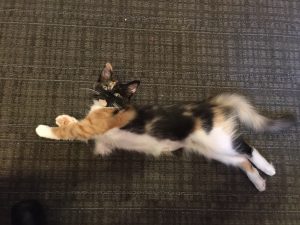 Have you ever noticed how a cat walks? I love watching Olivia walk—she has such a cute saunter. She’s a cat with catitude, but I never noticed that she and all other cats—in the home and in the wild—walk by moving the two right legs, then the two left legs. Ever notice that? This is maybe the only thing cats have in common with giraffes and camels.
Have you ever noticed how a cat walks? I love watching Olivia walk—she has such a cute saunter. She’s a cat with catitude, but I never noticed that she and all other cats—in the home and in the wild—walk by moving the two right legs, then the two left legs. Ever notice that? This is maybe the only thing cats have in common with giraffes and camels.
Housecats are most similar to their wild ancestors,  however—lions, tigers, and cheetahs. And one interesting similarity is their propensity for carrying that saggy tummy sack. I thought that happened after spaying a female cat—a hormone problem. But no. The saggy tummy is typical in both the male and the female house cat and wild cat, and there’s a reason for it.
however—lions, tigers, and cheetahs. And one interesting similarity is their propensity for carrying that saggy tummy sack. I thought that happened after spaying a female cat—a hormone problem. But no. The saggy tummy is typical in both the male and the female house cat and wild cat, and there’s a reason for it.
 That flabby flap is called a primordial pouch. It’s evidently a flap of skin padding that is designed to protect vital organs during fights. It also stretches to allow flexibility in movement when the cat runs and jumps. Who knew?
That flabby flap is called a primordial pouch. It’s evidently a flap of skin padding that is designed to protect vital organs during fights. It also stretches to allow flexibility in movement when the cat runs and jumps. Who knew?
I refer to Olivia as an accordion cat. I’ve never known a cat to appear so cobby—short cropped when walking or sitting, yet who can stretch so tall when reaching for something she wants. She also stretches out to be really long when lying around. I measured her and her standing length is 14 to 15 inches. She can stretch as long as 27 inches and that’s not including her tail. Do you have an accordion cat?
including her tail. Do you have an accordion cat?
I also learned this week that cats have 290 bones to our 206—yes, crammed into those tiny bodies. And they have 517 separate muscles. No wonder they can achieve such monumental leaps into the air and twists and also lay in such crazy positions while sleeping.
A cat is an interesting creature, indeed, from her pretty little head to her adorable toes which, by the way, are known as beans.






Our black male cat, Sylvester, is an accordion cat (great name BTW). He is average length when lying down or walking, but can stretch out greatly if he wants something that is up high. When he yawns, he opens his jaw to an astonishing width, also. Much different than our ginger female, Marmalade.